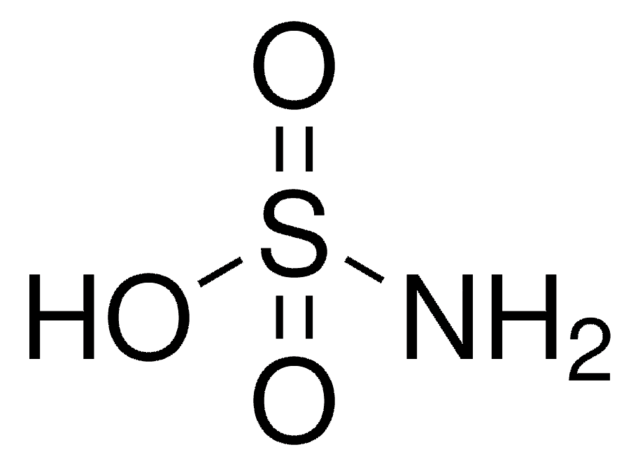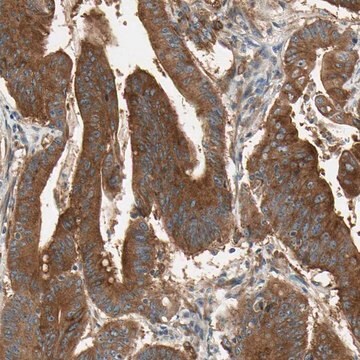推薦產品
等級
JIS special grade
化驗
99.0-100.5%
形狀
powder
存貨情形
available only in Japan
mp
>300 °C (lit.)
溶解度
water: soluble 12.51 g/L at 20 °C
密度
1.4862 g/cm3 at 20 °C
SMILES 字串
Nc1ccc(cc1)S(O)(=O)=O
InChI
1S/C6H7NO3S/c7-5-1-3-6(4-2-5)11(8,9)10/h1-4H,7H2,(H,8,9,10)
InChI 密鑰
HVBSAKJJOYLTQU-UHFFFAOYSA-N
尋找類似的產品? 前往 產品比較指南
訊號詞
Warning
危險聲明
危險分類
Eye Irrit. 2 - Skin Irrit. 2 - Skin Sens. 1
儲存類別代碼
13 - Non Combustible Solids
水污染物質分類(WGK)
WGK 1
閃點(°F)
Not applicable
閃點(°C)
Not applicable
個人防護裝備
dust mask type N95 (US), Eyeshields, Faceshields, Gloves
分析證明 (COA)
輸入產品批次/批號來搜索 分析證明 (COA)。在產品’s標籤上找到批次和批號,寫有 ‘Lot’或‘Batch’.。
Jinsong Zhang et al.
Water science and technology : a journal of the International Association on Water Pollution Research, 63(11), 2752-2758 (2011-11-05)
4-Aminobenzenesulfonate (4-ABS), an aromatic amine and recalcitrant toxic pollutant, is widely used in the dye and pharmaceutical industry. Pannonibactersp. W1 is a specialized microbial strain which can efficiently degrade 4-ABS. This study shows the feasibility of using the specialized strain
Yadong Sun et al.
Organic letters, 15(7), 1598-1601 (2013-03-19)
An efficient and convenient method was developed for the formation of 2-substituted benzothiazoles via a copper-catalyzed condensation of 2-aminobenzenethiols with nitriles. The developed method is applicable to a wide range of nitriles containing different functional groups furnishing excellent yields of
Han Ming Gan et al.
Chemosphere, 82(4), 507-513 (2010-11-26)
A co-culture consisting of Hydrogenophaga sp. PBC and Ralstonia sp. PBA, isolated from textile wastewater treatment plant could tolerate up to 100 mM 4-aminobenzenesulfonate (4-ABS) and utilize it as sole carbon, nitrogen and sulfur source under aerobic condition. The biodegradation
Kwan Kim et al.
The journal of physical chemistry. B, 109(40), 18929-18934 (2006-07-21)
Raman scattering measurements were conducted for 4-aminobenzenethiol (4-ABT) assembled on powdered copper substrates. Initially, very weak Raman peaks were detected, but upon attaching Ag nanoparticles probably via NH2 groups onto 4-ABT/Cu, distinct Raman spectra were observed. Considering the fact that
Poonam Singh et al.
Biodegradation, 17(6), 495-502 (2006-02-18)
A bacterial strain, PNS-1, isolated from activated sludge, could utilize sulphanilic acid (4-ABS) as the sole organic carbon and energy source under aerobic conditions. Determination and comparison of 16S r DNA sequences showed that the strain PNS-1 is closely related
我們的科學家團隊在所有研究領域都有豐富的經驗,包括生命科學、材料科學、化學合成、色譜、分析等.
聯絡技術服務








